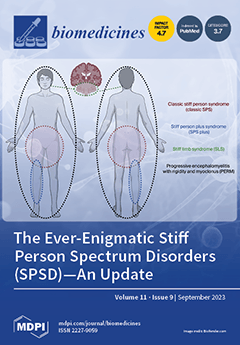Background: Pancreatic ductal adenocarcinoma (PDAC) is the third leading cause of death by cancer worldwide. Mostly diagnosed with locally advanced or metastatic disease, patients lack treatment options. Gene alterations (GAs) are frequently observed in PDAC, some of which are considered for molecular targeted
[...] Read more.
Background: Pancreatic ductal adenocarcinoma (PDAC) is the third leading cause of death by cancer worldwide. Mostly diagnosed with locally advanced or metastatic disease, patients lack treatment options. Gene alterations (GAs) are frequently observed in PDAC, some of which are considered for molecular targeted therapies (MTTs), with potential clinical benefits and improved outcomes. However, the applicability of molecular profiling (MP) for precision medicine in PDAC remains to be demonstrated. Methods: We conducted a retrospective analysis of all patients, aged ≥18 years with histologically confirmed PDAC, who underwent tumor MP between 2010 and 2020 in our institution as part of personalized medicine trials. The primary study endpoint was overall survival (OS), and (minimal follow-up was 6 months after MP). Results: Of 115 eligible patients, MP was successful in 102 patients (89%). KRAS mutations were the most frequent GAs, mostly G12D. Based on ESCAT classification, actionable GAs were found in 29 patients (28%), involving mainly
BRCA1 or
BRCA2 (5 (18%)),
HER2 (5 (18%)),
MTAP (5 (18%)), and
FGFR (3 (11%)). Only 12 of these 29 patients (41%, or 10% of the whole population) received MTTs, with a median progression-free survival of 1.6 months. Median OS was 19 months in patients with actionable GAs treated with MTTs (
n = 12 (11.8%)), 14 months in patients with actionable GAs treated with standard therapies (
n = 17 (16.7%)), and 17 months in patients without actionable GAs treated with standard therapies (
n = 73 (71.5%);
p = 0.26). The absence of liver metastases was associated with better OS (HR = 0.471,
p = 0.01). The highest OS following MTT was observed in patients with BRCA mutations treated with olaparib. Interpretation: Actionable GAs were found in more than a quarter of patients with advanced PDAC. Overall, targeting actionable GAs with MTTs was not associated with improved OS in this retrospective study with limited patient numbers. However, selected GA/MTT combinations (e.g., BRCA mutations/olaparib) were associated with a better outcome.
Full article






